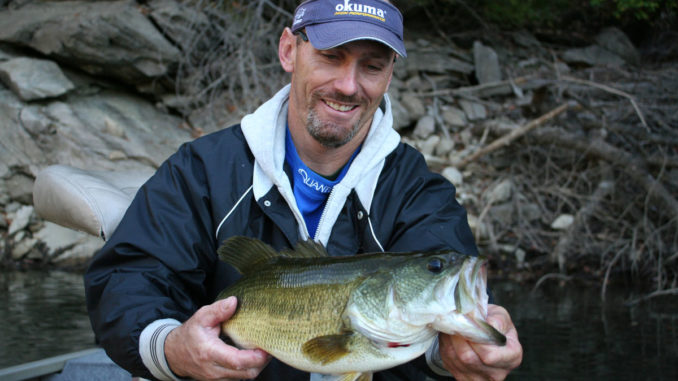
Although primarily noted for its trout population, South Carolina’s Lake Jocassee is an excellent bass fishery, and fall is prime time for catching quality bass, according to guide Rob McComas.
In September, fish will start to move out of the deeper water where they’ve been for months, McComas said. Not all will be up, but the migration will be on, setting the stage for good fishing throughout the fall.
“The first two to three weeks of September, you are probably not going to catch a lot of largemouths, but you will be shooting for good quality fish, 3 to 5 pounds. I have caught bass up to 7 pounds in September, but usually the bigger ones will start showing up and be more readily available in October,” said McComas (828-674-5041), who lives in Mill Spring, N.C.
Laydown trees are prime spots to target, he said, and some fish will also be starting to gather on longer points in September.
“As far as lures, I’ve always been a topwater fan; I like to throw walking-the-dog baits like Zara Spooks and Sammys in clear colors. They don’t have to be completely clear, just translucent,” he said. “Buzzbaits are also good, and twitching a rat bait around the treetops can sometimes be a pretty good way to catch the bass. I like cloudy, rainy days for the topwater baits. If it’s a sunnier day, you might get a fish to come up on a buzzbait better than a Spook.”
On bright, bluebird sky days, McComas said it is better to fish down in the trees with soft plastics.
“If they are not chasing topwater baits, you can slow down and catch them on worms around the trees,” he said. “Watermelon red is a great color on Jocassee. On bright, sunny days, a lot of times the fish will also be positioned on the steeper banks, and they will be in the little shade line along those banks.”
Some scattered schooling by spotted bass will be seen, too, often suspended deep over open water.
“It’s kind of hard to catch them if they are not chasing bait on the surface, but sometimes you can catch them on a drop-shot rig,” he said.
By the end of the month, bass will be more concentrated around the mouths of the rivers, and as fall progresses, they will move into the creeks and rivers following baitfish, he said; spotted bass will also be schooling in the creeks.
“Through October to the first of November, bass will be back in the creeks, and then they will begin migrating back out on the points in a winter pattern on into February,” he said.
Jocassee harbors four major species of bass — largemouth, smallmouth, spotted and redeye bass — although the redeye population has pretty much become completely hybridized with spotted bass.
“I have a hard time finding the smallmouth bass until January and February,” he said.

Be the first to comment